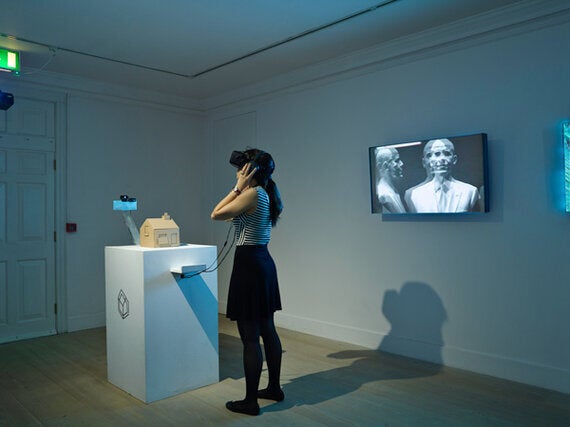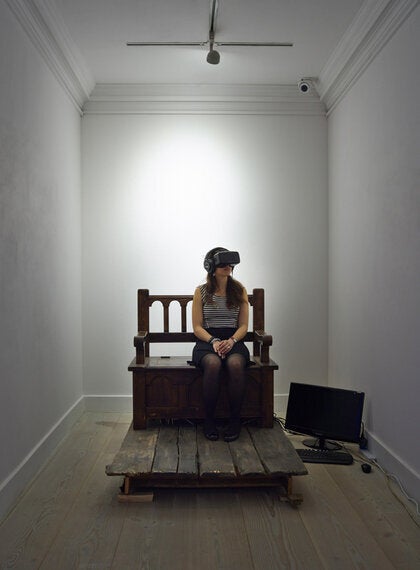
Upstairs in Mayfair's Gazelli Gallery stands a plinth on which rests a small cardboard house (above). Put on the Virtual Reality (VR) headset and earphones and, as if by magic, the house has morphed into something far grander. On entering its door, you find yourself in a room full of old masters, some of which spook you by suddenly flying off the walls and falling at your feet.
Bizarrely, on your right you can see your own reflection in a mirror. Then a handle appears which the by now invisible gallery assistant invites you to turn and you're transported into a snowy landscape. In front of you, a Lumiere screen is showing the first film ever made. Suddenly, you hear the sound of a train hurtling towards you. An engine crashes through the cinema screen, roars past you and tumbles down a precipice.
I've been experiencing a spectacular installation called Veil, a collaboration between artists Iain Nicholls and Tom Szirtes, one of three works included in Gazelli's Enter Through the Headset exhibition that highlights the blurred boundaries between real and virtual experiences.
"The Lumiere film was specifically chosen because they argue the Lumiere film has done for the moving image what they hope VR will do for the arts.," says Gazelli's owner Mila Askarova who champions non-traditional media in art and offers digital artists an online platform at Gazell.io.
The next installation is Nature Abstraction by UK-based Italian artist Matteo Zamagni, less of a formal structured piece, rather a more free-flowing one in which one is immersed into a complex planetary world in which abstract objects, some metallic-looking fractals, float by. In one section, you feel as if you are swimming in a sea of red coral occasionally interrupted by psychedelic flashes of light. An ethereal soundtrack accompanies the work.
Zamagni has worked in a variety of digital media, VR being but one string to his digital bow.
"I don't do VR for the sake of it, but to stimulate the senses. I'm exploring structures of reality, trying to visualise the invisible," he told me.

For the final work, you approach a bench (as above) and a gallery assistant hands you a coin. Once the VR headset is on, the bench begins to shake and you find yourself on a small ferryboat descending into a cavernous underworld on the River Styx. A scary-looking ferryman appears in front of you and asks for your money. Cleverly, it's taken from your grasp by the invisible gallery assistant.
You are then taken on a journey through the ghostly river strewn with floating dead bodies and where you are attacked by a three-headed monster before you finally make it to safety. Styx, the work of artistic duo Antoon Verbeeck and Filip Sterckx who are collectively called Skullmapping is a thrilling modern fairground ride. But is it art? Where is the boundary between the video game and the artwork?
These are questions yet to be fully answered. While the creative processes can be the same, the motivation can be at variance - the difference perhaps between a blockbuster movie and an art house picture.
"What I wanted to do with these works is to see how far we can have that separation between them being seen as an experience, an event-based piece, and as more of an artwork," says Askarova.
Much discussion has revolved around how to price works, what edition numbers should be, should there even be editions. The works on show at the Gazelli vary between £3,000-9,000. They've been priced to make them as accessible as possible to a wider audience.
For if VR is to become a mainstream artistic medium of the future, it has to be commercially sustainable in the way the gaming industry has become. One area of concern, though, for art, is how quickly technology can become outdated in a way that does not affect such other digital platforms as 3-D printing.
The idea of VR as art has still to be fully worked out. Mila Askarova is committed to testing the medium and supporting the artists, and retains an optimism about its future. After all, when the Lumiere brothers first started cinema, few thought it would become an art form.
"Students are now picking up coding classes at a young age. Presumably, you can assume that this is a form of language that's being taught. So if you think of that taking over our day-to-day lives, even outside of the art world, you wonder if it's just a matter of time before it becomes part of the art world."
Enter Through the Headset is showing at the Gazelli Art House, 39 Dover Street London W1S 4NN until 25 June.
All images are used with the permission of the artists and gallery.